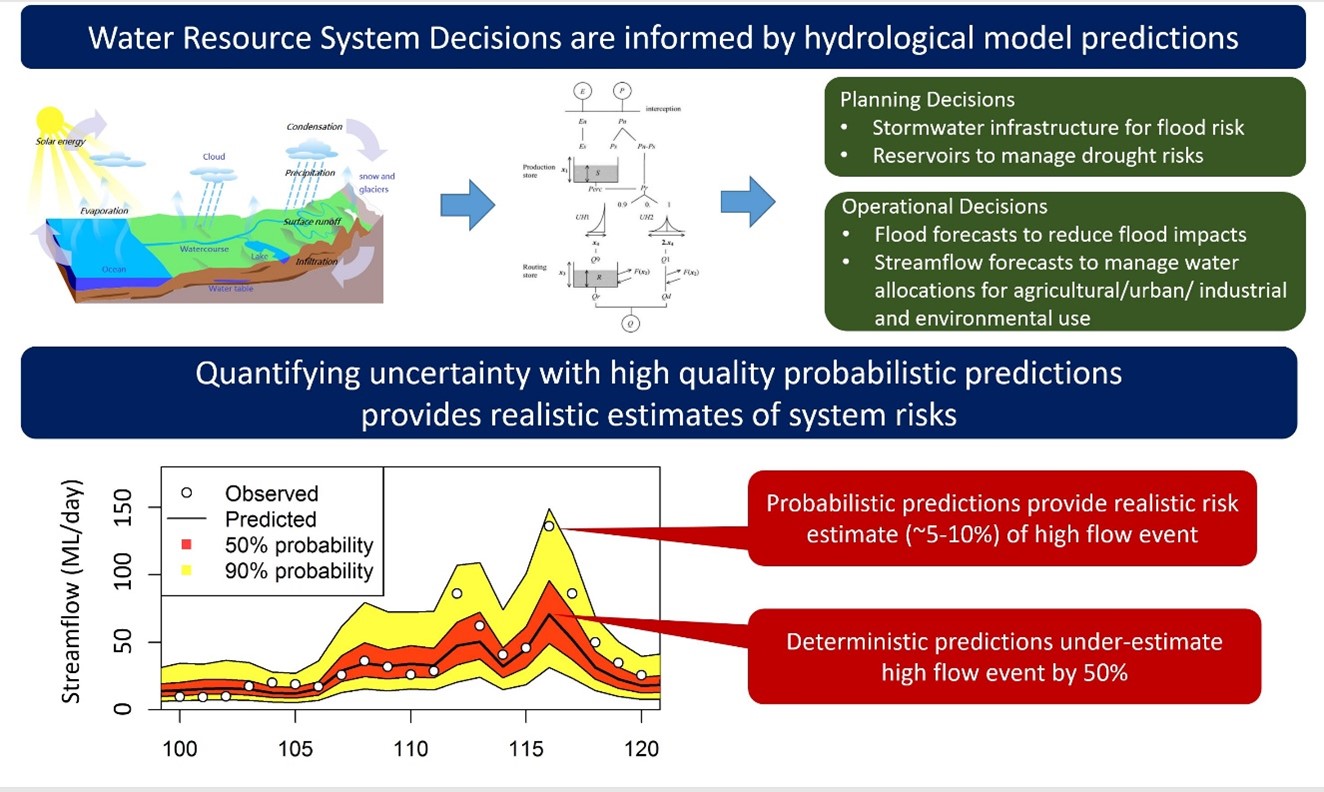Features
- Simple and easy to use interactive webapp for single site analysis
- Provides high quality probabilistic predictions that are robust to a wide range of common objective functions
- Incorporates the latest research advances in residual error model selection to handle common features of predictive errors, (see 'Help/About')
- Evaluates predictive performance using a range of commonly used metrics and diagnostics
- Users simply upload a time series of predictions and observations (see 'Getting Started')
- Users can easily download time series of probabilistic predictions, probability limits and summary metrics
- Command-line functionality in R package provides opportunity for automated analysis of a large number of sites
Benefits
- Probabilistic predictions provide realistic estimates of water resource system risks - without uncertainty, risks are under-estimated providing a false sense of security

- Incorporating the uncertainty enables decision-makers with different attitudes to risk aversion to act differently if aware of the uncertainty
- Encourages the modeller to think about the modelling processes and the quality of information used to inform decisions
- Decision-makers and the public have the 'right to know' all limitations of a design/analysis in order to make up their own minds and lobby for their individual causes
Development Team
Current lead developer
Dr David McInerney , Senior Research Associate, School of Architecture and Civil Engineering, University of Adelaide (Email)Contributors
Jason Hunter , PhD Candidate, School of Architecture and Civil Engineering, University of Adelaide (Email) Dr Mark Thyer , Associate Professor in Water Resources Engineering, School of Architecture and Civil Engineering, University of Adelaide (Email) Prof. Dmitri Kavetski , Professor in Environmental Modelling, School of Architecture and Civil Engineering, University of Adelaide (Email) Dr Bree Bennett , Senior Lecturer, School of Architecture and Civil Engineering, University of Adelaide (Email)1. Prepare and upload data
- Users need to calibrate their own hydrological model to streamflow 'observations' and use the model to generate streamflow 'predictions' for their catchment of interest
- Prepare a data file (csv format) of the streamflow 'predictions' and 'observations' for upload to the webapp
- See 'Simulation | Input Data' for details and an example input file
2. Evaluate and enhance predictive data
Introduction to evaluating probabilistic predictions: What makes a good probabilistic prediction? Introduction to residual diagnostics to evaluate error model assumptions Enhancing predictive performance Practical guidance on representing uncertainty in hydrological predictions3. Output
- Replicates: CSV data file of multiple individual time series (replicates) of probabilistic streamflow predictions generated by the residual error model - useful to be used as input into other models
- Probability Limits: CSV data file of the probability limits (5%, 95%) of the probabilistic predictions - useful for plotting purposes
- Summary: PDF file that summarises the analysis, includes input data details, summary metrics and diagnostics, and probabilistic time series
Residual Model Parameters
Data integrity checks
Performance metric plot type
Performance benchmarking
Metric Summary
Residual plot type
Output Data
Note: Interface must be opened in browser for downloads to be available - see option 'Open in Browser' at the top of the interface window.